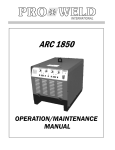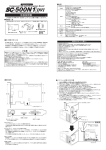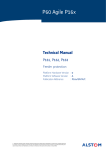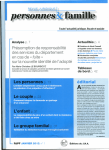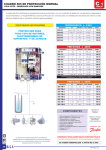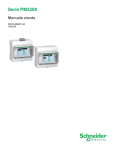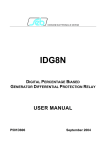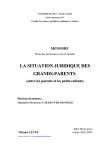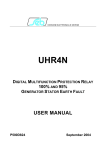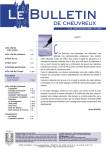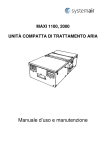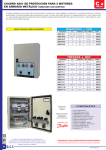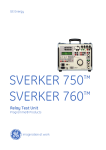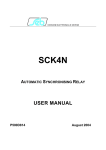Download IFX4NR - seb barlassina
Transcript
DIVISIONE ELETTRONICA E SISTEMI IFX4NR DIGITAL OVERCURRENT AND EARTH FAULT MULTIFUNCTION RELAY WITH RECLOSING FUNCTION USER MANUAL P500D802 July 2004 SEB Divisione Elettronica e Sistemi INDEX INDEX 1 2 3 4 5 6 7 8 9 GENERAL CHARACTERISTICS..................................................................................1 1.1 Auto-reclosing function (ANSI 79) .........................................................................4 1.2 Pole wearing monitoring function..........................................................................5 1.3 Breaker failure function..........................................................................................6 FRONT PANEL KEYS ..................................................................................................7 FRONT PANEL LED SIGNALINGS..............................................................................8 PROGRAMMING AND TEST .......................................................................................9 4.1 How to program the protection relay......................................................................9 4.2 How to modify a visualized parameter.................................................................10 4.3 Reset ...................................................................................................................10 4.4 Test of output relays ............................................................................................11 DISPLAY AND PROGRAMMING ...............................................................................12 5.1 Standard display..................................................................................................12 5.2 Visualization structure .........................................................................................13 5.3 Address and Time (fig. 1) ....................................................................................16 5.4 Protection function selection (fig. 1).....................................................................17 5.5 Nominal values set-up (fig. 2) ..............................................................................17 5.6 Thresholds and time delays set-up (fig. 2)...........................................................19 5.7 ANSI 79 – Auto-reclosing function programming – (fig. 2)...................................21 5.8 Pole wearing monitor programming (fig. 2)..........................................................22 5.9 Breaker – failure function programming (fig. 2) ...................................................23 5.10 Output relays programming (fig. 2) ......................................................................23 5.11 Digital inputs function programming (fig. 2) .........................................................26 5.12 Parameter values visualization (fig. 3).................................................................27 5.13 Events (fig. 3) ......................................................................................................29 5.14 Trip counters and pole wear index (fig. 3) ...........................................................31 INSTALLATION ..........................................................................................................33 6.1 Supplied kit ..........................................................................................................33 6.2 Cabling ................................................................................................................34 6.3 Relays R3 and R4 – Signaling / Command set-up ..............................................37 6.4 RS485 serial communication port........................................................................37 TIME DEPENDENT CURVES ....................................................................................39 TECHNICAL CHARACTERISTICS.............................................................................40 TABLES......................................................................................................................41 Information printed in this manual subject to change without prior notice. This manual must not be reproduced in whole or in part, in any form or by any means without the express written permission of SEB Divisione Elettronica e Sistemi. SEB Divisione Elettronica e Sistemi 1 GENERAL CHARACTERISTICS GENERAL CHARACTERISTICS The protection relay IFX4NR performs functions such as overcurrent and earth fault protection relay with the following additional functionalities: • • • auto - reclosing function circuit - breaker failure function circuit - breaker poles wearing monitoring The user can select one of the protection functions listed in the table below. Functions Two-phase overcurrent Three-phase overcurrent Two-phase overcurrent + earth fault Three-phase overcurrent + earth fault Earth fault (non directional) Stator earth fault (95%) Transformer case earth fault ANSI 50 51 50 51 50 51 51N 50 51 51N 51 N 64 S 64 T Measured currents I1, I2 I1, I2, I3 I1, I2, Io I1, I2, I3, Io Io Io Io All the set-up and measured parameters can be visualized on the front panel display and transmitted on the RS485 communication serial port. THRESHOLDS - the following thresholds are available: • • • phase overcurrent thresholds earth fault overcurrent thresholds poles wearing index threshold I> , I >> , I>>> Io>, Io>>, Io>>> I2T The available settings for each threshold are listed in Table A. Related to each threshold, partial and total counters of TRIP conditions are available. TRIP DELAYS - a programmable time delay (TI) is available for each overcurrent threshold; it can be programmed as definite time for all threshold available and dependent time in compliance with IEC 255-4 standard for the thresholds I> and Io>. For each threshold programmed as definite time, an additional programmable time delay (TA) is available; the additional time delay is added to time delay TI. The additional time delay activation is controlled by the digital inputs to allow the use of the IFX4NR relay with cooperating protection relays. The available settings for each timers are listed in Table A. OUTPUT RELAYS - the IFX4NR controls 4 output relays (named R1, R2, R3 and R4); these relays can be programmed to be activated on START or TRIP conditions of one or more thresholds. 1 SEB Divisione Elettronica e Sistemi GENERAL CHARACTERISTICS START instantaneous activation of the output relay when at least one of the measured currents exceeds the programmed threshold value TRIP activation of the output relay when the programmed time delay (TI or TI+TA) related to a threshold expires. The available relays can also be programmed to perform functions related to the autoreclosing ANSI 79 operations as: • • • • circuit breaker close command issue reclosing operations successfully completed reclosing operations failed reclosing function in progress • • • BREAKER FAILURE signaling TRIP (open circuit breaker) ON EXTERNAL COMMAND POLE WEARING INDEX threshold signaling (79 OK) (79 FR) (79 ON) or: The quiescent state of each single relay R1, R2, R3 and R4 can be programmed as normally energized (ON) or normally de-energized (OFF). An additional relay R5 (normally energized) is controlled by the self-diagnosis routines to report detected fault conditions. DIGITAL INPUTS - there are available 3 digital inputs to activate the following functions (when enabled by the programmed set-up): • additional time delay (related to one or more thresholds) • on/off thresholds • STATUS function (recording of measures on external event) • pilot wire fault monitoring • circuit breaker OPEN/CLOSE status (related to ANSI 79 function) • circuit breaker OPEN/CLOSE command detection (ANSI 79) • circuit breaker CLOSE command from external protection For each digital input can be programmed the condition that activates the related functions: HI voltage = LO voltage = > 20 V dc / ac 0 ÷ 10 V dc / ac The digital input acquisition is valid when the voltage value stays in the range HI or LO for at least 40 ms. 2 SEB Divisione Elettronica e Sistemi GENERAL CHARACTERISTICS DISPLAY OF MEASURES - the user can select the continuous display of a measured current (primary values); all the current measures can be transmitted to an external controller through the RS485 port. EVENTS - information related to the last 8 events (TRIP or STATUS) are recorded in the EEPROM memory. Information includes the threshold set-up and activated relays (TRIP event only), the measured currents, the digital input status, date and time of the event. SELF-DIAGNOSIS - the software includes a non stop monitoring module that controls the functionality of all hardware and software resources of the protection relay. Detected fault conditions are reported by: • diagnostic message on the display • glow of a red LED on front panel • R5 output relay drop-off The fault condition signaling stays until faults are pointed out by the monitoring module; during this condition the protection functions are suspended to avoid unsuitable tripping. STATUS FUNCTION - when the STATUS function is activated by one of the digital input (when programmed) the protection relay memorizes information related to measured currents and digital input status (see par. 5.13 - EVENTS). The recorded information allows an analysis of trip causes in co-operative protection relays systems. PILOT WIRE FAULT MONITORING - when the function is programmed, the digital input DIG2 is used to control the correct functionality of the pilot wire. Digital input DIG2 is always expected to be complementary of DIG1 input (HI-LO or LO-HI) to identify faults on pilot wire. The fault condition is reported as detected by the self-diagnosis module but the protection functions are not suspended; only the functions related to DIG1 digital input are suspended as the DIG1 status cannot be longer considered as true. The fault condition is reported when DIG1 and DIG2 signals are not complementary for more then 100 ms. REMOTE COMMUNICATION - the opto-insulated serial port RS485 can communicate with a personal computer or a remote control and monitoring system equipped with an RS485 interface or with a standard RS485/RS232 converter. All the set-up and measured parameters can be transmitted on the RS485 communication serial port; when communication is active (LED REMOTE glows), the operator on front panel can view the relay set-up but changes of parameters are disabled (ENTER and buttons disabled). 3 SEB Divisione Elettronica e Sistemi 1.1 GENERAL CHARACTERISTICS Auto-reclosing function (ANSI 79) The multi-shot auto-reclosing function can be activated for one or more of the thresholds related to ANSI 50 - 51 - 51N functions; the reclosing can be also activated from the acquisition of a digital input status (TRIP-EXT function set-up used for open command issue to the circuit-breaker on TRIP condition of a protection function external to the IFX4NR protection relay). When used the TRIP-EXT function, one of the output relays must be programmed to TRIP on the acquisition of the digital input status (“active status”) to allow the issue the OPEN command to the circuit-breaker. The same relay must be programmed to TRIP (and issue the OPEN command to the circuit-breaker) on the other protection thresholds as I>, I>>, I>>>, Io>, etc. The output relay programmed on the TRIP-EXT function will be released when the digital input status change in the “non-active” status (in others words, the output relay status follows the status of the digital input); the minimum activation time of the output relay is 110 msec. Auto-reclosing function set-up The function starts when one of the threshold (ENABLED on the auto-reclosing function) trips; one of the output relays must be programmed on the auto-reclosing function (ref. F9, paragraph 5.10) It is possible to program the first reclosure (RR) on the first TRIP condition and from 0 to 4 additional reclosures (RL) on the following trips. During the reclosing operations the condition is showed on the display The available settings for auto-reclosing function are listed in Table B (see paragraph 9). The lockout time TD is activated at the same time with the dead time TN2 and if a trip of a protection threshold occurs during the lockout time the auto-reclosing function will be inhibited (reclosing function FAIL). The lockout time TD must be shorter than the programmed TN2 time; this constraint is verified by the protection relay during the set-up and an error message will be displayed if required. The reclosing function will be also inhibited if one of the protection function operates (TRIP) during the last programmed reclosing operation (during TN1 if NRL = 0 or during TN2 if NRL ≥ 1). The output relay programmed on the auto-reclosing function (ref. F9, paragraph 5.10) will be activated for 100 ms. The auto-reclosing function will stay inhibited until the protection relay acquires the following signals: • • protection RESET switch-gear closing command CHINT 4 SEB Divisione Elettronica e Sistemi GENERAL CHARACTERISTICS Two of the digital input (3 available) must be programmed as: • • switch-gear closing command (CHINT) switch-gear opening command (APINT) Switch-gear closing command - CHINT When detected by the protection relay (programmed digital input – see 5.11 the switchgear closing command CHINT will cause the reset of the auto-reclosing function (ready to operate). The command is managed equivalent to the first reclosure (RR). Switch-gear opening command - APINT When detected by the protection relay (programmed digital input - see 5.11) the switchgear closing command CHINT will cause the reset and inhibition of the auto-reclosing function; the inhibition will stay inhibited until the protection relay acquires a protection RESET command or a switch-gear closing command CHINT. The following signaling functions can be programmed on output relays: • • • successful reclosing function failed reclosing function reclosing function in progress (79 OK) (79 FR) (79 ON) When the signaling function 79 OK and 79 FR are active, the related output relays will be activated for 1 sec.; the relay programmed as 79 ON will stay activated during the reclosing function operations. The status of the last reclosing operation is recorded in the EVENT memory related to the following TRIP condition of the protection relay. 1.2 Pole wearing monitoring function When enabled by the operator, the function is activated by each of the following circuitbreaker open commands: • TRIP condition of one of the programmed IFX4NR thresholds if an output relay is programmed to operate on the TRIP condition • acquisition of the APINT command (circuit-breaker open command) from a digital input programmed APINT • acquisition of the TRIP condition from an external protection relay through a digital input programmed TRIP-EXT (to issue the open command to the controlled circuitbreaker) The IFX4NR protection computes the I2t pole wearing index, where: t= I= TPOLO time, programmable from 0.005 to 1.000 s, resolution 0.001 s measured current (in primary values) at the TRIP condition (see above conditions – TRIP, APINT, TRIP-EXT) 5 SEB Divisione Elettronica e Sistemi GENERAL CHARACTERISTICS The computation of the I2t index is done for each pole and the result expressed as kA2s is added to the related register. There are 3 registers (PL1, PL2, PL3), one for each pole of the circuit-breaker; when the BIPOLAR insertion is used, only two registers are used. The registers can be resetted by the operator. The operator must program the time TPOLO (medium time to extinguish the electric arc in the circuit-breaker) used by the I2t function. One of the output relays can be programmed to be activated on a I2t threshold (I2T>) programmable from 0.0 to 9999.999 kA2s , resolution 0.001 ; the threshold is common to all poles of the circuit breaker (PL1, PL2, PL3 registers). The output relay will remain activated until the I2t registers are resetted or until the RESET push-button on the protection relay is pressed. 1.3 Breaker failure function When activated by the operator, the function is active on each open command issue, specifically on: • • TRIP condition of one or more thresholds acquisition of the TRIP condition of an external protection relay through a digital input programmed TRIP-EXT (to issue the open command to the controlled circuitbreaker) The operator must program the time delay BRK-FAIL maximum opening time of the circuit-breaker). Following one of the above open command, the protection relay IFX4NR if a current is still flowing in the circuit-breaker poles verifies after a time delay of BRK-FAIL seconds. If one of the currents is still present (greater than 0.05 In) the protection relay will activate an output relay programmed to TRIP on the BF (breaker failure) function. If all the measured currents are lower than 0.05 In, no output relays will be activated and the circuit breaker is considered successfully opened. NOTE: the function is programmable if the programmed insertion of the protection relay will include the line current measuring function (BIPOLAR, TRIPOLAR, BIPOL+Io, TRIPL+Io). 6 SEB Divisione Elettronica e Sistemi 2 FRONT PANEL KEYS FRONT PANEL KEYS The 5 push-buttons on the front panel allow to visualize all the protection parameters and to modify the protection set-up. right arrow down arrow ENTER programming session activation or parameter confirmation change or increment of the selected parameter RESET reset of the protection relay (ref. par. 4.3) VISUALIZATION OF PARAMETERS • all visualizations are circular and they can be displayed using the two arrow pushbuttons. • the structure of the visualizations and their contents are showed in Figures 1, 2, and 3. • when the sealable transparent front panel is installed only the arrow push-buttons and the RESET push-button are accessible to prevent unauthorized modification of the protection set-up. MODIFICATION OF PARAMETERS • remove the transparent sealable front panel to access ENTER and buttons. 7 push- SEB Divisione Elettronica e Sistemi 3 FRONT PANEL LED SIGNALINGS FRONT PANEL LED SIGNALINGS POWER (green) ⊕ auxiliary supply available (red) ⊕ fault condition detected by SELF-DIAGNOSIS software or by PILOT WIRE FAULT MONITORING function REMOTE ⊕ communication session active on RS485 port FAIL (red) I> I>> (red) EXT (red) Io (red) ⊕ trip condition on I>, I>> and I>>> thresholds ⊕ trip condition on digital input programmed as TRIP-EXT (external protection function) ⊕ trip condition on Io>, Io>>, Io>>> thresholds The last trip condition (threshold indication) is also showed on front panel display; more information on trip condition are presented in the recorded EVENT (see par. 5.13). 8 SEB Divisione Elettronica e Sistemi 4 PROGRAMMING AND TEST PROGRAMMING AND TEST The protection relay is easily programmable following the instructions in the next paragraphs: • • HOW TO PROGRAM THE PROTECTION RELAY HOW TO MODIFY A VISUALIZED PARAMETER All parameters can be freely modified; the proper protection set- up as required by the plant management is submitted to the operator's judgment. 4.1 How to program the protection relay The programmable parameters are showed in Figures 1, 2 and 3 at the following references: B2 ÷ B7 C1 D1 ÷ D5 E1S ÷ E5S E1R ÷ E13R E1M ÷ E3M E1B - E2B F1 ÷ F12 G1 ÷ G3 R1 ÷ R20 relay address (RS485) and date/time relay function nominal values, contrast etc thresholds and time delays ANSI 50-51-51N parameters function ANSI 79 parameters pole wearing index parameters breaker failure output relays functions digital input functions partial trip counters reset The programming sequence is the following: 1) SELECT the visualization (on display) of the parameter to be modified using the arrow push-buttons 2) ACTIVATE the PARAMETER MODIFICATION session depressing the [ENTER] push-button and modify the parameter value 3) END the parameter modification session depressing again the [ENTER] pushbutton 4) REPEAT the procedure from 1) to 3) for all the parameters required to obtain the new protection relay set-up 5) CONFIRM the new protection relay set-up at the visualization CONFIRM PROG? (Fig. 2, ref. H1) within 5 minutes depressing the push-buttons buttons [ENTER], up to visualize YES and [ENTER] again to confirm. NOTE: The protection relay continues to operate using the previous set-up until the new set-up is confirmed as at point 5) above; the visualization of the modified parameters before the new set-up confirmation is only temporary to allow an easy definition of the new protection set-up. 9 SEB Divisione Elettronica e Sistemi PROGRAMMING AND TEST If the new set-up is not confirmed within 5 minutes from the last pressed push-button, the protection relay visualizes again the previous set-up (the parameters set-up that the protection relay is still using). 4.2 How to modify a visualized parameter When the parameter to be modified is visualized on front panel display do the following sequence: 1) PRESS [ENTER] to activate the parameter modification session If one or more parameters are modifiable, on the first of them will appear a blinking cursor. If no parameters are modifiable, no blinking cursor will appear. 2) MODIFY THE PARAMETER pressing the arrow push-buttons and when two parameters are modifiable, the push-button allows to point-out the parameter to be modified (the selected parameter will blink) when numerical parameters are pointed-out the push-button allows to select the digit to be modified increasing of the parameter a) the digits are increased by 1 unit b) 3) the other parameters are presented following the selection list PRESS [ENTER] to end parameter modification session The modification session is ended and the parameter stops to blink NOTE: if a numerical parameter is selected out of the accepted range (as shown in Table A) when the push-button [ENTER] is pressed for few seconds an error message will be displayed as: Data Error and the parameter will be displayed again with the former value. 4.3 Reset When the push-button [RESET] is pressed, the protection relays returns to the standard condition: • reset of glowing LEDs 10 SEB Divisione Elettronica e Sistemi PROGRAMMING AND TEST • drop-off of tripped relays • reset of any parameter changed but not confirmed (parameters are shown as confirmed at the end of the last programming session) • display on STANDARD MODE (Fig. 1, ref. A1 - par. 5.1) 4.4 Test of output relays When the output relays test is selected (Fig. 2, ref. F12) it is possible to command an output relay (one at the time) to trip from the current status allowing functional tests on electrical plants. The output relays are activated with the following sequence: 1) SELECT THE VISUALIZATION of the desired output relay to be tested TEST R1 OFF 2) PRESS [ENTER] to activate the test session; the message OFF will start to blink. 3) PRESS ; and the message on the display will change as: TEST R1 ON 4) PRESS [ENTER] to command the instantaneous trip of the output relay (change of the current status). The relay will stay on the new condition until: • the • the [ENTER] push-button is pressed and the sequence at points 3 and 4 is repeated (presenting OFF condition) or [RESET] push-button is pressed The same procedure will be used for R2, R3 and R4 relays. 11 SEB Divisione Elettronica e Sistemi 5 DISPLAY AND PROGRAMMING DISPLAY AND PROGRAMMING The contents and the structure of the displayed messages are shown in figures 1, 2 and 3; the references A1, B1, B2 etc. identify specific displayed messages in the figures. 5.1 Standard display A1 - STANDARD DISPLAY It is the standard displayed message without operator's intervention (no push-buttons pressed for at least 5 minutes) or when the RESET push-button has been pressed. The displayed information is function of the protection relay status. NORMAL FUCTIONING During this state the following information can be visualized (as defined by set-up): Protection function (ANSI code) - the display shows the ANSI codes of the selected functions (ref. C1 - FUNCTION SELECTION). Measured current - the display shows one of the measured currents; the current to be visualized is selected by operator (ref. D4). The current is visualized as primary value; if the selection of the current to be visualized refers to a current not measured (depending on FUCTION SELECTION) no values are presented. ON TRIP CONDITION When a trip condition occurs the protection relay visualizes the TRIP message that includes the threshold related to the trip; the displayed messages are as the following: TRIP I> TRIP BRK-FAIL TRIP I2T TRIP EXT The information of the trip, as well the glowing of the related LEDs, is displayed until the [RESET] push-button is pressed. If a new trip condition occurs, the displayed information will be updated; information related to previous trips are recorded in EVENTS memory. When the auto-reclosing function (ANSI 79 status) is selected during the operation the following messages will be displayed: ON OF OF DIG auto-reclosing function programmed auto-reclosing function inhibited (not programmed) auto-reclosing function temporary inhibited by external command (digital input) FAULT CONDITION When a permanent or temporary fault condition is detected by the self-diagnosis module, the following message is displayed: 12 SEB Divisione Elettronica e Sistemi DISPLAY AND PROGRAMMING FAIL eeeeeeee The string eeeeeeee can be: F.PILOT Detected fault condition on pilot wire; the function related to DIG1 digital input is suspended Corrective action - verify pilot wire (short or open circuit) HARDWARE Detected fault condition on hardware or software resources of the protection relay; all functions are suspended. Corrective action - replace the protection relay and contact SEB post sales service 5.2 Visualization structure A1 ANSI 50 51 51N B1 IFX4NR mod nn C1 FUNCTION aaaaaaaa SET-UP ALTERNATIVE DISPLAYS B2 PROTOCOL yyyyyyyy B3 BAUDRATE nnnn FAIL eeeeeeee TRIP I>> I1 xxxxx A Io xxxxx A B4 NR RELAY xxx B5 SER. NR. zzzzzzzz B6 VERS SW zz.zz B7 dd/mm/yy hh:mm:ss 2 PHASE, 3 PHASE, 2 PH+Io, 3PH+Io EARTH, STATOR95, CASE TR NOMINAL VALUES Nominal data and time (FIG. 2) THRESHOL SET-UP THRESHOLD set-up (FIG. 2) RELAYS FUNCTION OUTPUT relays set-up (FIG. 2) DIGITAL INPUT DIGITAL INPUTS set-up (FIG. 2) H1 CONFIRM PROG?.. MEASURES & EVENTS SIGNAL STATUS EVENTS COUNTERS Display of SIGNALS and OUTPUT RELAYS status (FIG. 3) Display of EVENTS data (FIG. 3) Display of COUNTERS data (FIG. 3) Figure 1 13 SEB Divisione Elettronica e Sistemi From FIGURE 1 SET-UP DISPLAY AND PROGRAMMING NOMINAL VALUES D1 In = x A Ion= j A D2 In prim ccccc A D3 Ion prim ccccc A D4 DISPLAY eeeeeeee D5 CONTRAST LEV n THRESHOL SET-UP E1S I> ccc nn.nn E2S I> xxxxxx A E3S TI eeeee xx.xx s E4S TA I> zz.zz s E5S TA I> eeeeeeee I>> ccc nn.nn I>> xxxxxx A TI INDIP xx.xx s TA I>> zz.zz s TA I>> eeeeeeee I>>> ccc nn.nn I>>> xxxxxx A TI INDIP xx.xx s TA I>>> zz.zz s TA I>>> eeeeeeee Io> ccc nn.nn Io> xxxxxx A TI eeeee xx.xx s TA Io> zz.zz s TA Io> eeeeeeee Io>> ccc nn.nn Io>> xxxxxx A TI INDIP xx.xx s TA Io>> zz.zz s TA Io>> eeeeeeee Io>>>ccc nn.nn Io>>> xxxxxx A TI INDIP xx.xx s TA Io>>> zz.zz s TA Io>>> eeeeeeee E1R ANSI 79 ccc E2R R.LENTE NRL n E3R TRR xxx.x s E4R TN1 xxx.x s E5R TRL xxx.x s E6R TN2 xxx.x s E7R TD xxx.x s E8R I> cc I>> cc E9R I>>> cc E10R Io> cc Io>> cc E11R Io>>> cc E12R TRIP-EXT cc E13R TRIP-EXT eeeeeeee E1M MON I2T ccc E2M TPOLO z.zzz s E3M I2T kA2s xxx.xxxx E1B BRK FAIL ccc E2B BRK FAIL zz.zz s F1 R1 NORM ccc F2 R1 I> xxxxxxxx F3 R1 I>> xxxxxxxx F4 R1 I>>> xxxxxxxx F5 R1 Io> xxxxxxxx F6 R1 Io>> xxxxxxxx F7 R1 Io>>> xxxxxxxx F8 R1 EXT xxxxxxxx F9 R1 ANS79 xxxxxxxx F10 R1 BF xxxxxxxx F11 R1 MONIT xxxxxxxx F12 TEST R1 yyyyyyyy G2 DIG2 cc xxxxxxxx G3 DIG3 cc xxxxxxxx RELAYS FUNCTION R2 NORM ccc R3 NORM ccc R4 NORM ccc DIGITAL INPUT G1 DIG1 cc xxxxxxxx J1 CONFIRM PROG?.. To FIGURE 3 Figure 2 14 From FIGURE 2 MEASURES & EVENTS COUNTERS EVENTS SIGNALS STATUS 15 Figure 3 R16 PL2 kAs yyyyyyy R15 PL1 kAs yyyyyyy R14 TRIP EXT T eeee R13 TRIP EXT P eeee R12 Io>>> T eeee R11 Io>>> P eeee R6 I>>> T eeee R5 I>>> P eeee R4 I>> T eeee I>> P eeee I> T eeee R1 I> P eeee R3 R7 R17 PL3 kAs yyyyyyy Io> P eeee Q15 E1 Time hh:mm:ss Q14 E1 Date dd/mm/yy Q13 E1 DIG3 vv Q12 E1 DIG2 vv R2 Q7 E1 I2 nn.nn In Q6 E1 I1 nn.nn In Q5 E1 DIG eeeeeeee Q4 E1 T-Tot ww.ww s Q3 E1 RELAY i,j,k Q2 E1 aaaa xx.xx In Q1 E1 aaaaaaaa E8 aaaaaaaa P6 POLI INT xxxxxxxx P5 ANSI 79 eeeeeeee P4 Io=xx.xx yyyyy A L6 P3 I3=xx.xx yyyyy A Io>>> status P2 I2=xx.xx yyyyy A L5 P1 I1=xx.xx yyyyy A Io>> status MEASURES STATUS L4 N2 DIG3 ww Io> status N1 DIG1 ww DIG2 ww L3 DIGITAL STATUS M2 I>>> status R3 ccc R4 ccc M1 L2 R1 ccc R2 ccc I>> status RELAYS STATUS L1 I> status THRESHOL STATUS R8 R18 TOT PRG cccc Io> T eeee Q8 E1 I3 nn.nn In L7 TRIP EXT status R9 R19 DATE PRG dd/mm/yy Io>> P eeee Q9 E1 Io nn.nnIon L8 ANSI 79 status R20 TIME PRG hh:mm:ss R10 Io>> T eeee Q10 E1 ANS79 hhhhhh L10 BRK FAIL status L9 MON I2T status Q11 E1 DIG1 vv SEB Divisione Elettronica e Sistemi DISPLAY AND PROGRAMMING SEB Divisione Elettronica e Sistemi 5.3 DISPLAY AND PROGRAMMING Address and Time (fig. 1) B1 - RELAY MODEL (not programmable) IFX4NR mod. A5 Models: A5 (nominal earth fault current = 5A) A1 (nominal earth fault current = 1A) The nominal phase current is programmable 1 A or 5 A B2 - COMMUNICATION PROTOCOL (programmable) B2 PROTOCOL xxxxxxxx The communication protocol is programmable between the followings: STANDARD: ASCII SEB protocol MODBUS: Modbus protocol (SLAVE) When the MODBUS protocol is selected the following display is showed to allow the selection of the transmission speed: B3 BAUDRATE xxxx The xxxx parameter is selectable between the followings: 300 - 600 - 1200 - 2400 - 4800 - 9600 When the STANDARD protocol is selected the baud rate is automatically selected by the protection relay. B4 - ADDRESS (programmable) NR RELAY 001 Programmable address from 001 to 255. The number is used on RS485 port to address a specific relay when two or more protection relays are linked on the same serial line. B5 - RELAY SERIAL NUMBER (not programmable) SER. NR 0012345 16 SEB Divisione Elettronica e Sistemi DISPLAY AND PROGRAMMING B6 - SOFTWARE REVISION LEVEL (not programmable) SW REV zz.zz B7 - TIME/DATE (programmable) dd/mm/yy hh:mm:ss Time and date are programmable and they are used to mark recorded events. NOTE: the clock is not provided with back-up battery, therefore a loss of auxiliary supply will force time/date to the following condition: 01/01/90 00:00:00 5.4 Protection function selection (fig. 1) C1 - FUNCTION SELECTION (programmable) FUNCTION xxxxxxxx The selection of the active function defines the selectable thresholds. FUNCTION ANSI SELECTION ACTIVE THRESHOLDS Two-phase overcurrent Three-phase overcurrent 50 51 50 51 2 Phase 3 Phase I> I>> I>>> Two-phase + earth fault Three-phase + earth fault 50 51 51N 50 51 51N 2 Ph+Io 3 Ph+Io I> I>> I>>> Io> Io>> Io>>> 51N 64S 64T EARTH FT STATOR95 CASE TR Io> Io>> Io>>> Earth fault (non-directional) Stator earth fault (95%) Transformer case earth-fault Examples: FUNCTION 2 PHASE 5.5 FUNCTION 3 PH+Io FUNCTION EARTH FT Nominal values set-up (fig. 2) D1 - NOMINAL CURRENT SELECTION In (programmable) In = x A Ion= 1 A In Ion In = x A Ion= 5 A nominal phase current programmable 1 A or 5 A nominal earth current (defined by models - manufacturer set-up) 17 SEB Divisione Elettronica e Sistemi Ion = 5 A: IFX4NR model A5 DISPLAY AND PROGRAMMING Ion = 1 A: IFX4NR model A1 D2 - PRIMARY PHASE CURRENT (programmable) In prim xxxxx A Primary phase current value of the installed phase CTs; the value is programmable from 0001 to 18500 A. D3 - PRIMARY EARTH CURRENT (programmable) Ion prim xxxxx A Primary current value of the installed earth CT; the value is programmable from 0001 to 18500 A. NOTE: when Holmgreen insertion is used, select Ion prim = In prim. D4 - STANDARD DISPLAY SELECTION (programmable) DISPLAY eeeeeeee It allows to select the standard displayed information (ref. A1) when no trip condition occurs and no fault condition have been detected by the self-diagnosis module; the available selections are the following: ANSI I1 I2 I3 Io STATO79 displays of ANSI code displays measured phase current I1 displays measured phase current I2 displays measured phase current I3 displays measured earth current Io displays the status of the reclosing function The list of the selectable currents depends on the programmed FUNCTION SELECTION (ref. C1); the current is displayed in primary values (the value depends on D2 and D3 setups). Selection examples: DISPLAY ANSI DISPLAY I1 D5 - DISPLAY CONTRAST LEVEL (programmable) CONTRAST LEV x The display contrast level is programmable from 0 to 9. 18 DISPLAY STATO79 SEB Divisione Elettronica e Sistemi DISPLAY AND PROGRAMMING The backlighted display is switched off if no push-button is pressed for at least 5 minutes; when one of the front panel push- button is pressed the display is switched on. 5.6 Thresholds and time delays set-up (fig. 2) In the programming session are displayed only the thresholds available depending on FUNCTION SELECTION set-up (ref. C1, paragraph 5.4). The information and set-ups related to threshold I> in the following points (references E1S÷E5S) are effective for all the thresholds I>>, I>>>, Io>, Io>>, Io>>> just taking into consideration the change of the threshold identification (with limits as presented in table A). E1S - THRESHOLD LEVEL SET-UP (programmable) I> ccc nn.nn I> threshold identification I>, I>>, I>>>, Io> etc.) ccc ON - enabled threshold OFF - disabled threshold (available but not active) nn.nn threshold level expressed in terms of relative values In Ion (threshold I>, I>>, I>>>) (threshold Io>, Io>>, Io>>>) Examples: I> ON 01.50 I>>> OFF 12.00 Io>> ON 05.00 E2S - THRESHOLD LEVEL IN PRIMARY VALUES (not programmable) I> xxxxxx A The programmed threshold (ref. E1) is shown in terms of primary current; the value depends on the programmed CTs primary values (ref. D2 and D3 – paragraph 5.5). I> xxxxxx threshold identification (I>, I>>, etc.) threshold level expressed in Amperes (primary values) E3S - TIME DELAY SET-UP (programmable) TI eeeee xx.xx s Set-up of time-delay to the activation (TRIP) of the programmed output relays when the measured current exceeds the threshold level. Parameter TI eeeee: time delay characteristic 19 SEB Divisione Elettronica e Sistemi DISPLAY AND PROGRAMMING For I> and Io> thresholds, the time delay can be selected between one of the following: INDIP DIP=A DIP=B DIP=C independent time delay time delay as curve A IEC 255-4 (inverse time) time delay as curve B IEC 255-4 (very inverse time) time delay as curve C IEC 255-4 (extremely inverse time) For the remaining thresholds the TI parameter is fixed as INDIP (independent time). Parameter xx.xx: Time independent - time delay (seconds) to activate the programmed output relays: the output relay trips when the measured current exceeds the threshold level for at least xx.xx seconds. Time dependent - value of the parameter K (see formulas paragraph 7). TI DIP=B 02.50 K TI DIP=A 10.00 K TI INDIP 03.25 s NOTE: the index K or s is shown coherently to the selected time-delay characteristic when the push-button ENTER is pressed. E4S – ADDITIONAL TIME DELAY SET-UP (programmable) The selection is displayed only when a TIME INDEPENDENT characteristic has been selected (TI INDIP at ref. E3); when TIME DEPENDENT characteristic has been programmed, the selection will not be displayed. TA I> xx.xx s The additional time delay TA is programmable from 00.00 to 99.99 seconds; please note that at least one of the digital inputs should be programmed to activate time delay function (ref. G1, G2, G3 – paragraph 5.11). The additional time delay TA is added to the time delay TI to obtain the output relay trip when the TI+TA time expires. The additional time delay TA will be added if the time delay TI is programmed at least equals to 50 ms (digital input acquisition time – 40 ms) E5S – DIGITAL INPUT ACTIVE ON THRESHOLD (not programmable) TA I> eeeeeeee It shows the digital input programmed to activate the additional time delay TA on the displayed threshold. The parameter eeeeeeee can show one of the following values: 20 SEB Divisione Elettronica e Sistemi DISPLAY AND PROGRAMMING DISABLED none of the digital inputs has been programmed to activate an additional time delay related to threshold I> DIG1 digital input DIG1 activates the TA delay on threshold I> DIG2 digital input DIG2 activates the TA delay on threshold I> DIG3 digital input DIG3 activates the TA delay on threshold I> When a TIME DEPENDENT characteristic threshold has been programmed the visualization is omitted as no additional time delays can be defined and programmed on time dependent delays. 5.7 ANSI 79 – Auto-reclosing function programming – (fig. 2) The available settings for each parameter are listed in the table at paragraph 1.1. The programming of the reclosing function will be always presented independently from the selection at ref. C1 – paragraph 5.4) E1R – AUTO-RECLOSING FUNCTION ENABLED (programmable) ANSI 79 ccc ccc ON – enabled function OFF – disabled function E2R – ADDITIONAL RECLOSURES (programmable) R.LENTE NRL n n number of enabled additional reclosures (0 ÷ 4) E3R – E4R – SHORT-TIME RECLOSING DEAD and RECLAIM TIME PROGRAMMING (programmable) E3R TRR xxx.x s TRR TN1 E4R TN1 xxx.x s DEAD TIME short-time (first) reclosure RECLAIM TIME short-time (first) reclosure Example: TRR 000.3 s TN1 005.0 s E5R – E6R – E7R – LONG DEAD TIME RECLOSURES PARAMETER (programmable) E5R TRL xxx.x s TRL E6R TN2 xxx.x s Long dead time 21 E7R TD xxx.x s SEB Divisione Elettronica e Sistemi TN2 TD DISPLAY AND PROGRAMMING Reclaim time Lockout time (inhibition of further reclosures) E8R – E9R – E10R – E11R – THRESHOLDS ENABLING ON AUTO-RECLOSING FUNCTION (programmable) The list of the thresholds that can be enabled on the auto-reclosing function depends on the enabled protection functions. When the overcurrent function is enabled (ANSI 50-51), the following information is displayed: E8R E9R I>>> cc 0. cc I>> cc When the earth-fault function (ANSI 51N) is enabled, the following information is displayed: E10R Io> cc Io>> cc cc E11R Io>>> cc ON – enabled function OFF – disabled function E12R – E13R – RECLOSING ENABLING ON EXTERNAL TRIP (programmable) It allows the enabling of the auto-reclosing function on the external trip (the external trip condition is detected by a specifically programmed digital input) . E12R TRIP-EXT cc cc E13R TRIP-EXT eeeeeeee ON – enabled function OFF – disabled function The parameter eeeeeeee can show one of the following values: DISABLED none of the digital inputs has been programmed on external trip acquisition DIG1 digital input DIG1 activates the reclosing function on external trip DIG2 digital input DIG1 activates the reclosing function on external trip DIG3 digital input DIG1 activates the reclosing function on external trip Please note that at least one of the digital inputs should be programmed to activate time delay function (ref. G1, G2, G3 – paragraph 5.11). 5.8 Pole wearing monitor programming (fig. 2) The programming of the pole wearing index function will be always presented independently from the selection at ref. C1 – paragraph 5.4. 22 SEB Divisione Elettronica e Sistemi DISPLAY AND PROGRAMMING E1M – POLE WEARING MONITOR FUNCTION ENABLED (programmable) MON I2T cc cc ON – enabled function OFF – disabled function E2M – CIRCUIT BREAKER EXTINCTION TIME (programmable) TPOLO z.zzz s z.zzz typical electric arc extinction time of the circuit programmable 0.005 ÷ 9.999 seconds, resolution 0.001 sec. breaker E3M – POLE WEARING THRESHOLD (programmable) I2T kA2s xxxx.xxx xxxx.xxx 5.9 value of the pole wearing index to enable the signaling (excessive wearing of the circuit breaker poles) programmable 0.000 ÷ 9999.999 kA2s, resolution 0.001 kA2s Breaker – failure function programming (fig. 2) The programming of the breaker-failure function will be always presented independently from the selection at ref. C1 – paragraph 5.4. E1B – CIRCUIT BREAKER FUNCTION ENABLING (programmable) BRK FAIL ccc cc ON – enabled function OFF – disabled function E2B – CIRCUIT BREAKER OPENING TIME (programmable) BRK FAIL z.zz s z.zz 5.10 circuit breaker opening time (when the time expires ALL the measured currents must be lower than 0.05 In) programmable 0.01 ÷ 9.99 seconds, resolution 0.01 seconds Output relays programming (fig. 2) The session allows to program the activation of the output relays R1, R2, R3 or R4 on START or TRIP conditions for each threshold. 23 SEB Divisione Elettronica e Sistemi DISPLAY AND PROGRAMMING In the programming session are displayed only the thresholds available depending on FUNCTION SELECTION set-up (ref. C1 – paragraph 5.4). Equivalent information and set-up related to relay R1 is available for the relays R2, R3 and R4 just changing the relay identification. F1 – OUTPUT RELAY R1 QUIESCENT STATUS (programmable) R1 NORM xxx Programming of the R1 relay status when no START or TRIP conditions are activated (none of the measured currents exceed their thresholds). NORM OFF: normally de-energized (energized status on activation) NORM ON: normally energized (de-energized status on activation) F2 ÷ F4 – OUTPUT RELAY R1 ACTIVATION ON THRESHOLDS ANSI 50-51 (programmable) F2 R1 I> xxxxx F3 R1 I>> xxxxx F4 R1 I>>> xxxxx Programming of the R1 output relay activation (START/TRIP/NONE) when one of the phase currents exceeds the programmed threshold I>. The parameter xxxxx is selectable as the following: START instantaneous output relay R1 activation when one of the measured phase currents exceeds the programmed threshold I>, I>> or I>>> TRIP output relay R1 activation when one of the measured phase currents exceeds the programmed threshold level I>, I>> or I>>> for at least TI or TI+TA seconds NONE no activation related to threshold I>, I>> or I>>> F5 ÷ F7 – OUTPUT RELAY R1 ACTIVATION ON THRESHOLDS ANSI 50N-51N (programmable) F5 R1 Io> xxxxx F6 R1 Io>> xxxxx F7 R1 Io>>> xxxxx Programming of the R1 output relay activation (START/TRIP/NONE) when one of the phase currents exceeds the programmed threshold I>. The parameter xxxxx is selectable as the following: START instantaneous output relay R1 activation when one of the measured phase currents exceeds the programmed threshold Io>, Io>> or Io>>> 24 SEB Divisione Elettronica e Sistemi DISPLAY AND PROGRAMMING TRIP output relay R1 activation when one of the measured phase currents exceeds the programmed threshold level Io>, Io>> or Io>>> for at least TI or TI+TA seconds NONE no activation related to threshold Io>, Io>> or Io>>> F8 – OUTPUT RELAY ACTIVATION ON EXTERNAL COMMAND (programmable) R1 EXT xxxxx The parameter xxxxx is selectable as the following: TRIP output relay R1 activation on external command NONE no activation related to external commands The external command is acknowledged through a digital input programmed on the TRIP EXT function (see paragraph 5.11). F9 – OUTPUT RELAYS ACTIVATION ON AUTO-RECLOSING FUNCTION R1 ANS79 xxxxxxxx The parameter xxxxxxxx is selectable between the following: NO AZION RICHIUS 79 OK 79 FR 79 ON no activation on ANSI 79 function relay enabled to issue switch-gear close command relay activation to signal successfully completed reclosing function relay activation to signal reclosing operation failed relay activation to signal reclosing operation in progress F10 – RELAY ACTIVATION ON BREAKER FAILURE FUNCTION (programmable) R1 BF xxxxx The parameter xxxxx is selectable as the following: TRIP output relay R1 activation on BREAKER FAILURE condition NONE no activation on BREAKER FAILURE function F11 – RELAY ACTIVATION ON POLE WEARING MONITOR (programmable) R1 MONIT xxxxxxxx The parameter xxxxx is selectable selectable between: TRIP output relay R1 activation on excessive POLE WEARING condition NONE no activation on POLE WEARING MONITOR function 25 SEB Divisione Elettronica e Sistemi DISPLAY AND PROGRAMMING F8 – TEST OF OUTPUT RELAY R1 TEST R1 xxxxxxxx See paragraph 4.4 5.11 Digital inputs function programming (fig. 2) For each digital input one of the following functions are selectable: a) additional time delay (related to one or more thresholds) b) ON / OFF threshold c) STATUS function (recording of measures on external command) d) pilot wire fault monitoring (only DIG2 monitors DIG1). e) switch-gear close command detection (ANSI 79 function) f) switch-gear open command detection (ANSI 79 function) g) close command issue on external command (TRIP EXT) When function a) is programmed, a message is displayed at ref. E5S, par. 5.6. When the function of more than one digital input refers to a threshold, the priority will be the following: a) OF selection (threshold disabled) has the priority on TA function (additional time delay) b) the ALL selection (ALL the thresholds) has the priority on single threshold selection. G1 – DIGITAL INPUT DIG1 SET-UP (programmable) DIG1 cc xxxxxxxx Programming of the function related to digital input channel 1 (DIG1). Parameter cc: programming of the condition that activates the function related to digital input DIG1; the condition is selectable between HI and LO. Parameter xxxxxxx: programming of the function related to digital input DIG1; the following functions are selectable: NONE TA I> TA I>> TA I>>> TA Io> TA Io>> no functions active related to digital input DIG1 additional time delay on threshold I> additional time delay on threshold I>> additional time delay on threshold I>>> additional time delay on threshold Io> additional time delay on threshold Io>> 26 SEB Divisione Elettronica e Sistemi TA Io>>> TA ALL OF I> OF I>> OF I>>> OF Io> OF Io>> OF Io>>> OF BF OF I2T OF RR OF RL OF RICH OF ALL STATUS TRIP EXT CHINT APINT DISPLAY AND PROGRAMMING additional time delay on threshold Io>>> additional time delay on all thresholds threshold I> disabled threshold I>> disabled threshold I>>> disabled threshold Io> disabled threshold Io>> disabled threshold Io>>> disabled BREAKER FAILURE function disabled POLE WEARING MONITOR function disabled short-time (first) reclosing function disabled – ANSI 79 long-time reclosing function disabled – ANSI 79 reclosing function disabled all thresholds disabled activation of status function (see paragraph 1) circuit breaker close command from external protection relay circuit breaker CLOSE command detection (ANSI 79 function) circuit breaker OPEN command detection (ANSI 79 function) G2 – DIGITAL INPUT DIG2 SET-UP (programmable) DIG2 cc xxxxxxxx Programming of the function related to digital input channel 2 (DIG2); the selections available are the same as presented for DIG1 (ref. G1) plus the following: MONITOR activation of pilot wire monitor function. G3 – DIGITAL INPUT DIG3 SET-UP (programmable) DIG3 cc xxxxxxxx Programming of the function related to digital input channel 3 (DIG3); the selections available are the same as presented for DIG1 (ref. G1). 5.12 Parameter values visualization (fig. 3) L1 ÷ L10 – THRESHOLDS STATUS The actual status of each threshold is displayed; only the thresholds available depending on FUNCTION SELECTION set-up are visualized (ref. paragraph 5.4). For each threshold are displayed the threshold identification (I>, I>> etc.) and the threshold status; the status can show one of the following values: ON OFF active threshold disabled threshold (programmed OFF at ref. E1S, E1M, E1B, par. 5.6) 27 SEB Divisione Elettronica e Sistemi OFF_DIG DISPLAY AND PROGRAMMING threshold programmed active but momentary disabled by a digital input actual status. Examples: I> ON I>>> OFF TRIP EXT ON BRK FAIL OFF_DIG M1 – M2 – OUTPUT RELAY STATUS The actual status of each output relay is displayed; for each relay the following information is displayed: relay identification (R1, R2, R3, R4) relay status (ON – activated, OFF – non activated) Note that ON/OFF do not necessary mean energized or de-energized (see ref. F1). N1 – N2 – DIGITAL INPUT STATUS The actual status of each digital input is displayed. For each digital input the following information is presented: digital input identification (DIG1, DIG2, DIG3) digital input status (HI or LO) P1 ÷ P6 – MEASUREMENT DISPLAY The actual value of the measured currents is displayed; only the measured currents (depending on FUNCTION SELECTION – ref. C1, paragraph 5.4) are displayed. For each current the following information is displayed: • • • current identification (I1, I2, I3, Io) actual value expressed as In or Ion actual primary value expressed as Amperes For the reclosing function the following information is displayed: • • • • • ON OF OF DIG IN CORSO FAIL RIC function enabled function disabled (non programmed) function momentary disabled by digital input status reclosing function in progress reclosing function failed (and function enabled) For the pole wearing monitor function the following information is displayed: • • OK circuit breaker pole wearing status lower than the programmed threshold USURATO circuit breaker pole wearing status higher than the programmed threshold 28 SEB Divisione Elettronica e Sistemi 5.13 DISPLAY AND PROGRAMMING Events (fig. 3) On the display are shown the memorized information related to the last 8 TRIP events. The 8 events are recorded and identified with a progressive number from 1 to 8; the more recent event shows a lower number. Q1 – EVENT NUMBER E1 cccccccc The index E1, E2 ... E8 identifies the memorized event. The parameter cccccccc gives information on the kind of event and it can show one of the following values: NONE 0. I>> I>>> Io> Io>> Io>>> STATUS POWER ON CHINT APINT TRIP-EXT BRK FAIL I2T> no event memorized event on trip threshold I> event on trip threshold I>> event on trip threshold I>>> event on trip threshold Io> event on trip threshold Io>> event on trip threshold Io>>> information recorded on external command switch-on of the protection relay (auxiliary power) event on close command (ANSI 79 function) event on open command (ANSI 79 function) event on external close command event on breaker failure condition detection event on pole wearing monitor threshold I2T> For the events NONE and POWER ON no other information is presented: for the other events the following displays give more detailed information on the event. For the events CHINT and APINT only the status of the last reclosing command (Q10), the digital input status (Q11 ÷ Q13) and the time and date (Q14 and Q15) will be presented. Q2 – TRIP THRESHOLD E1 I> xx.xx In It shows the threshold related to the TRIP condition of the protection relay and the value of the threshold (in relative terms). The information is not shown on STATUS or POWER ON events. Q3 – ACTIVATED OUTPUT RELAYS E1 RELAY nnnnnnn 29 SEB Divisione Elettronica e Sistemi DISPLAY AND PROGRAMMING It shows the list of the output relay activated by the threshold trip. Examples: E1 RELAY 1,3,4 E3 RELAY 1,4 When no output relays have been activated (no relays programmed to TRIP on the threshold) the following message will be displayed: E1 RELAY NONE Q4 – TOTAL TIME DELAY ON TRIP E1 T-Tot www.ww s It is shown the total delay to the TRIP of the output relays from the overcurrent detection; when additional delays are activated, the change of the status of the digital input that controls the additional delay during the delay itself could bring to a total time different from the sum of the programmed delays. If the total time is greater than 999 seconds the display of tenths is omitted. When the event is memorized on external command (STATUS), the message N/A (Not Applicable) is shown instead of the number of seconds. E1 T-Tot N/A Q5 – DIGITAL CHANNELS RELATED TO MEMORIZED EVENT E1 DIG 1, 3 The list of the digital inputs related to the memorized event is displayed (STATUS function command or additional time TA enabled – ref. E4 par. 5.6). If no digital inputs were activated, the message NONE is displayed. Q6 – Q7 – Q8 – Q9 – MEMORIZED MEASURED CURRENTS ON EVENT E1 I1 yy.yy In E1 I2 yy.yy In E1 I3 yy.yy In E1 Io yy.yy In The values of the measured currents at the event are displayed; the values are expressed as In and Ion terms. There are presented only the currents measured coherently with the selection on FUNCTION SELECTION set-up (ref. C1 – paragraph 5.4). 30 SEB Divisione Elettronica e Sistemi DISPLAY AND PROGRAMMING Q10 – STATUS OF THE LAST RECLOSE COMMAND E1 ANSI79 hhhhhhhh The status of the last reclosing command is presented; the parameter hhhhhhhh can have the value: RRR RL1R RL2R RL3R RL4R Successful first (fast) reclosing Successful 1st long time reclos. Successful 2nd long time reclos Successful 3rd long time reclos. Successful 4th long time reclos. RRF RL1F RL2F RL3F RL4F Failed first (fast) reclosing Failed 1st long time reclos Failed 2nd long time reclos Failed 3rd long time reclos Failed 4th long time reclos The information of a failed reclosing is presented when a protection function trips during a reclosing cycle; if no previous reclosing function has been executed the information NONE will be showed. Q11 – Q12 – Q13 – DIGITAL INPUTS STATUS ON EVENT E1 DIG1 vv E1 DIG2 vv E1 DIG3 vv The status of the digital inputs at the event are displayed. The parameter vv can assume the value HI or LO. Q14 – Q15 – DATE AND TIME OF THE EVENT E1 Date dd/mm/yy E1 Time hh:mm:ss The date and time of the event are showed 5.14 Trip counters and pole wear index (fig. 3) In this section are displayed the total and partial counters of the output relay activation (on TRIP conditions) for each thresholds, the numbers of the programming sessions with the date and time of the last confirmed programming session and the actual value of the wearing index for each pole of the circuit breaker (expressed as kA2s). The total counters, the number of confirmed programming sessions and the date and time of the last confirmed programming session are not modifiable or resettable; the information related to the last programming session are used to control unauthorized access. The partial counters and the wearing index of the poles can be modified following the standard set-up procedure for parameters as described at paragraph 4.2; the partial counters and the wear index of the poles are immediately modified in the memory (the recorded values are immediately resetted without the need of the programming confirmation). 31 SEB Divisione Elettronica e Sistemi DISPLAY AND PROGRAMMING R1 ÷ R12 – TRIP COUNTERS I> P I> T cccc cccc Display of the partial (P) and total (T) counters of the TRIP condition related to each threshold. When the value exceed 9999 the counter starts again from 0000. The counters are identified by the threshold name (I>, Io>, etc.); there are presented only the counters related to the active thresholds coherently with the selection on FUNCTION SELECTION set-up (ref. C1 – paragraph 5.4). The partial counters are modifiable in the range from 0000 to 9999 following the standard set-up procedure (paragraph 4.2). R13 ÷ R14 – TRIP ON EXTERNAL COMMAND COUNTERS TRIP EXT P cccc TRIP EXT T cccc Display of the partial (P) and total (T) counters of the TRIP condition related to external command. R15 ÷ R17 – POLE WEARING INDEX REGISTERS PL1 kA2s yyyyyyyy PL2 kA2s yyyyyyyy PL3 kA2s yyyyyyyy Display of the wearing index registers of the poles of the circuit breakers; the content of each register is expressed as kA2s; it is present a register for each pole of the circuit breaker. With the 2 PHASE selection at ref. C2, the register PL3 will not be displayed. R18 ÷ R20 TOTAL PROGRAMMING SESSIONS AND DATE/TIME OF THE LAST PROGRAMMING SESSION TOT PRG eeee DATE PRG dd/mm/yy TIME PRG hh:mm:ss Display of the number of confirmed programming sessions (from the factory set-up) and the date and time of the last confirmed programming session. 32 SEB Divisione Elettronica e Sistemi INSTALLATION 6 INSTALLATION 6.1 Supplied kit RK VERSION – 19” rack installation (the proper rack is supplied by SEB) • protection relay module IFX4NR with rear socket • transparent front panel for rack installation • blister with items 1-2-3-4-5 CS VERSION – flush mounting installation • protection relay module IFX4NR with rear socket • transparent front panel for rack flush mounting installation • n° 2 brackets for flush mounting • blister with items 1-2-3-4-5 • blister with item 6 1 2 3 6 4 5 Sacchetto BLISTER 1) n° 8 screws to fix wire terminals of current circuits 2) n° 4 screws to fix the relay rear socket on the 19” rack (or on the two brackets for flush mounting) and n° 2 screws to fix (optionally) the protection relay on the front of the 19” rack 3) n° 2 knobs to fix the transparent front panel 4) n° 8 washers to be used to fix wire terminals (current) 5) n° 8 growers to be used to fix wire terminals (current) 6) small items to fix brackets on the cabinet (only CS version) The knobs to fix the transparent front panel must be screwed through the panel the front panel itself; the operation will create a screw thread in the plastic material and the knobs will never be missed. 33 SEB Divisione Elettronica e Sistemi 6.2 INSTALLATION Cabling Current circuits It is suggested to terminate the current wirings using eyelet terminals. Minimum suggested wire cross section: 2,5 mm2 With reference to the insertion diagram in the next page, the currents measured by the protection relay have the following matching: I1 I2 I3 Io terminals A1 – A2 terminals B1 – B2 terminals C1 – C2 terminals D1 – D2 For the functions as earth fault overcurrent , stator earth fault 95% (64S) and transformer case earth fault (64T) only the current Io is measured. Io terminals D1 – D2 The terminal D1-D2 must to be connected to a CT sensible to earth currents (64S – on star connection of the generator, 64T on the earth connection of the transformer case). Other circuits (output relays etc.) It is suggested to terminate the current wiring using plug terminals. Minimum suggested wire cross section: 1,5 mm2 34 SEB Divisione Elettronica e Sistemi INSTALLATION Insertion 35 SEB Divisione Elettronica e Sistemi INSTALLATION 36 SEB Divisione Elettronica e Sistemi 6.3 INSTALLATION Relays R3 and R4 – Signaling / Command set-up The protection relay is supplied with R3 and R4 relays configured as SIGNALING RELAYS, with 2 change-over output contacts with breaking capability equals to 0.2 A at 110 Vdc, L/R = 40 ms, 100000 operations. Each R3 and R4 relay can be configured as COMMAND RELAY with 1 change-over output contact with breaking capability equals to 0.5 A at 110 Vdc, L/R = 40 ms, 100000 operations. The new configuration is obtained with the following cabling: R3 6.4 29 N.C. 28 27 N.O. 26 25 24 COM. 35 N.C. 34 33 N.O. 32 31 30 COM. R4 RS485 serial communication port The digital protection relay IFX4NR presents an insulated serial interface RS485 halfduplex that allow the multi-drop connection up to 31 protection units. There are available 2 selectable communication protocols (ref. B2 paragraph 5.3) When the STANDARD Seb communication protocol is selected, the transmission speed is automatically selected between 300 to 9600 bauds and the protocol is ASCII-HEX. When the MODBUS communication protocol is selected, the transmission speed can be programmed between 300 to 9600 bauds (ref. B3, par. 5.3). To integrate the protection relay in control systems, the documentation related to the protocol is freely available on request. It is suggested to use a shielded twisted pair AWG22; terminal 19 (not connected internally) can be used for shields connections. 37 SEB Divisione Elettronica e Sistemi INSTALLATION Line H 120 Ohm Line L PROTEZ. 2 It is suggested to terminate the serial line with a resistance 120 Ω, 1/4 W. 38 PROTEZ. 3 23 21 20 23 22 21 20 23 22 21 20 PROTEZ. 1 22 120 Ohm CONTROLLORE SEB Divisione Elettronica e Sistemi 7 TIME DEPENDENT CURVES TIME DEPENDENT CURVES I / Ithresh I / Ithresh Time dependent characteristic t= I / Ithresh 39 Ki ∗ K α I −1 Ithresh + 0.02s Curve IEC 255-4 A B C Ki 0.14 13.5 80 α 0.02 1 2 K Parameter 0.01 ÷ 20.00 s I / Ithresh Ratio between the greatest measured current and the threshold I> or Io> SEB Divisione Elettronica e Sistemi 8 TECHNICAL CHARACTERISTICS TECHNICAL CHARACTERISTICS Measuring inputs Rated phase current (In) Rated earth current (Ion) Thermal withstand continuously Thermal withstand for 1 s Rated frequency Primary CT’s current 1 A / 5 A programmable 1Ao5A 4 In / Ion 100 In / Ion 50 / 60 Hz 1 ÷ 18500 A Output contacts ratings Number of relays (note 1) Rated current Rated voltage Contact configuration Breaking capability (note 2) - tripping relays (R1, R2) - signaling relays (R3, R4, R5) (note 3) Mechanical life 4+1 5A 250 V change over 0.5 A 0.2 A > 106 Digital inputs Number of inputs External control voltage Typical current (sink) 3 as Uaux 2 mA Data transmission Standard Communication protocol Transmission speed Optional RS485 half duplex MOD-BUS ASCII 300 – 9600 baud selectable fibre optic module Auxiliary supply Frequency (Vac) Burdens (min/max) 24 ÷ 320 Vdc ± 20% 48 ÷ 230 Vac ± 20% 47 ÷ 63 Hz 5 / 10 W Environmental conditions Operation Transport and storage Relative humidity (without condensation) Protection degree for flush mounting (optional) Weight -10 / +60 °C -25 / +80 °C < 95% IP 52 (IP 54) 2.5 kg Range Note 1) Note 2) Note 3) The additional relay R5 is controlled by self-test program Breaking capability at 110 Vdc, L/R 40 ms, 100.000 operations The output contacts of R3 and R4 relays can be configured as signaling or tripping relays 40 SEB Divisione Elettronica e Sistemi 9 TABLES TABLES Table A Thresholds and time delays THRESHOLDS ANSI Setting Resolution I> I>> I>>> Phase overcurrent 0.10 ÷ 5.00 In 0.10 ÷ 40.00 In 0.01 In 0.01 In Io> Io>> Io>>> Earth fault overcurrent 0.01 ÷ 2.00 Ion 0.10 ÷ 10.00 Ion 0.01 Ion 0.01 Ion I2T Pole wearing index 0.0 ÷ 9999.999 kA2s 0.01 kA2s TPOLO Circuit breaker opening time 0.0 ÷ 9.999 s 0.001 s 0.0 ÷ 9.99 s 0.01 s Characteristic curves Curves (as IEC 255-4) Characteristic constant A, B, C 0.10 ÷ 20.00 s 0.01 s Time definite (all thresholds) Time delay 0.02 ÷ 99.99 s 0.01 s Additional time delay (all time definite thresholds) Additional time delay 0.00 ÷ 99.99 s 0.01 s 50 – 51 51N ,64S, 64T POLE WEARING INDEX BREAKER FAILURE BRK FAIL Time dependent (I> and Io>) Circuit breaker opening time 41 SEB Divisione Elettronica e Sistemi Table B TABLES Reclosing function parameters Parameters Setting Resolution 0÷4 1 NRL N° of additional reclosures (except first) TRR Dead time 1 0.1 ÷ 200.0 s 0.1 s TN1 Reclaim time 1 0.1 ÷ 200.0 s 0.1 s TRL Dead time 2, 3, 4, 5 0.1 ÷ 200.0 s 0.1 s TN2 Reclaim time 2, 3, 4, 5 0.1 ÷ 200.0 s 0.1 s TD Lockout time (inhibition of further reclosures) 0.0 ÷ 200.0 s 0.1 s 42 43 44 SEB DIVISIONE ELETTRONICA E SISTEMI - UFFICIO COMMERCIALE Via Segantini, 5 - 20825 BARLASSINA (MB) - tel. +39 0362 5669.1 - fax +39 0362 556622 web: www.seb-barlassina.it mail to: [email protected]

















































